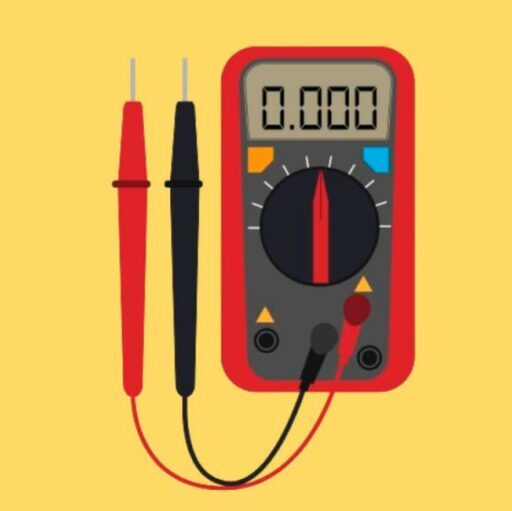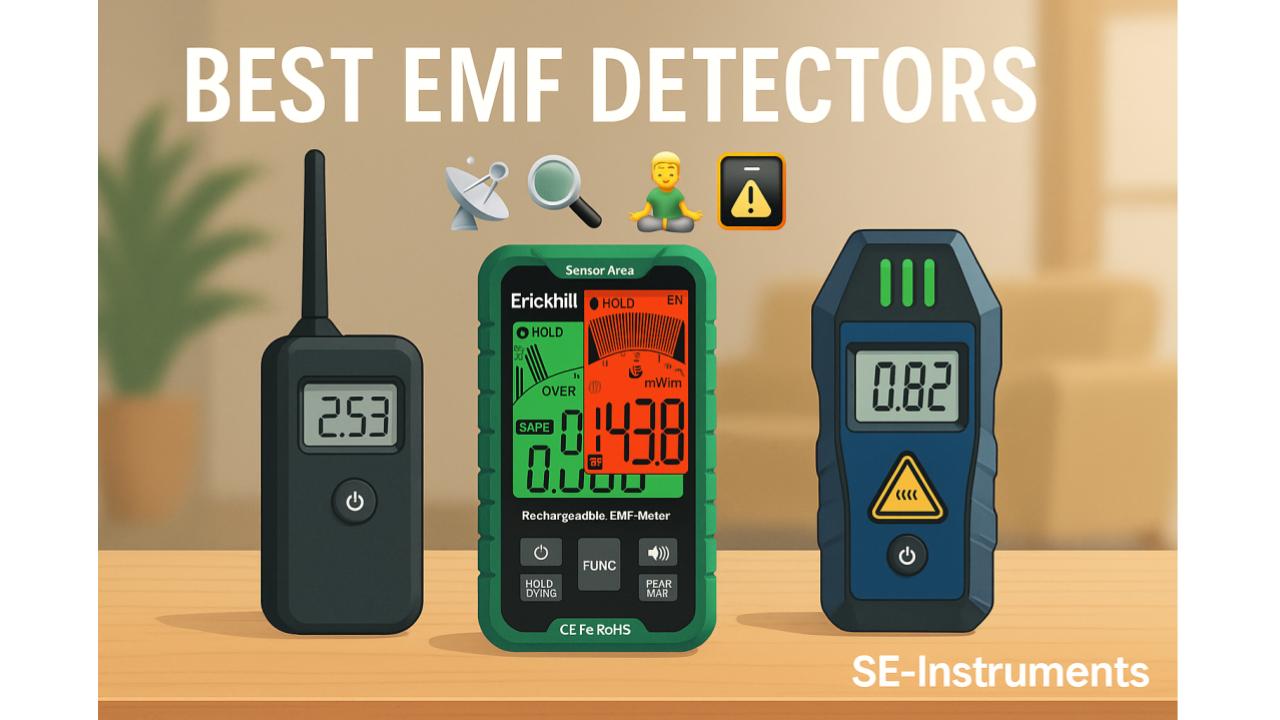⚠️ Feeling Zapped? It Might Be Time to Measure the Invisible.
In today’s wireless world, we’re surrounded by invisible energy — from smartphones and Wi-Fi routers to power lines and smart home devices. While these technologies bring convenience, they also raise questions about prolonged exposure to electromagnetic fields (EMFs). Whether you’re EMF-sensitive, health-conscious, or simply curious, measuring your environment is the first step toward peace of mind.
That’s where EMF meters come in.
⚡📶 EMF Detectors ⭐⭐⭐⭐
These powerful tools help you detect and quantify the invisible waves around you — offering insight, clarity, and control. In this article, we’ll explore the best EMF meters on the market, what to look for when choosing one, and how to use them to reclaim your space from the noise of modern life.
Ready to tune in to what’s been quietly humming all around you? Let’s begin.
Table of Contents
Key Factors to Consider
Important considerations when choosing an EMF meter is what type of fields you want to measure. Basic meters might only detect one type of EMF, while more advanced models can measure multiple types.
You should also think about accuracy, ease of use, and whether you need features like data logging or audio alerts. We researched and tested multiple EMF meters to find the ones that give reliable readings and are simple to use.
Best EMF Meters and Detectors
Below is our full list of the best EMF meters and detectors. These tools help you measure electromagnetic fields in your home, office, or other spaces where you want to check EMF levels.
GQ EMF-390 Multi-Field Detector
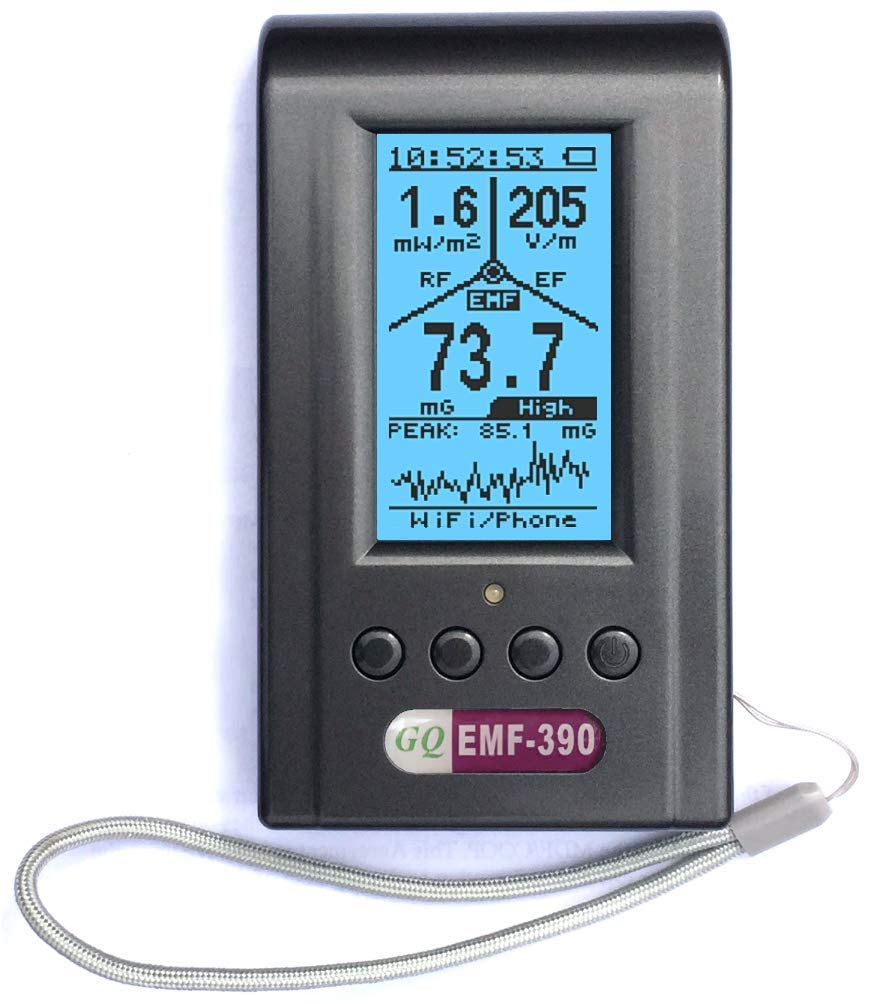
This advanced EMF detector delivers professional-grade measurements across multiple frequency ranges, making it worth the investment for anyone serious about monitoring electromagnetic fields.
Pros
- Detects three different types of radiation (EMF, ELF, and RF) in one compact device
- Built-in spectrum analyzer provides detailed frequency analysis up to 10GHz
- Smart source identification tells you what’s creating the readings
Cons
- Multiple display screens can feel overwhelming when you first start using it
- Battery life drains faster when running all sensors simultaneously
- Learning curve required to understand all the advanced features
The GQ EMF-390 impressed me right out of the box with its clear display and instant readings. You get three measurement modes that work together or separately. The device quickly identifies whether you’re dealing with power lines, cell towers, or microwave sources.
Testing this meter around my home revealed some surprising results. My cell phone peaked at over 4000 mW/m2 during calls, which the meter flagged as a high exposure situation. The safety suggestions appeared automatically on screen, helping me understand what the numbers actually mean.
The built-in spectrum analyzer sets this detector apart from basic EMF meters. You can see exactly which frequencies are active in your environment. This feature proved invaluable when checking for 5G signals and identifying specific sources of interference.
The compact size makes it easy to carry around, though the 10-ounce weight feels substantial in your hand. Battery performance varies depending on which sensors you’re running, but the USB-C charging keeps downtime minimal.
ERICKHILL EMF Meter
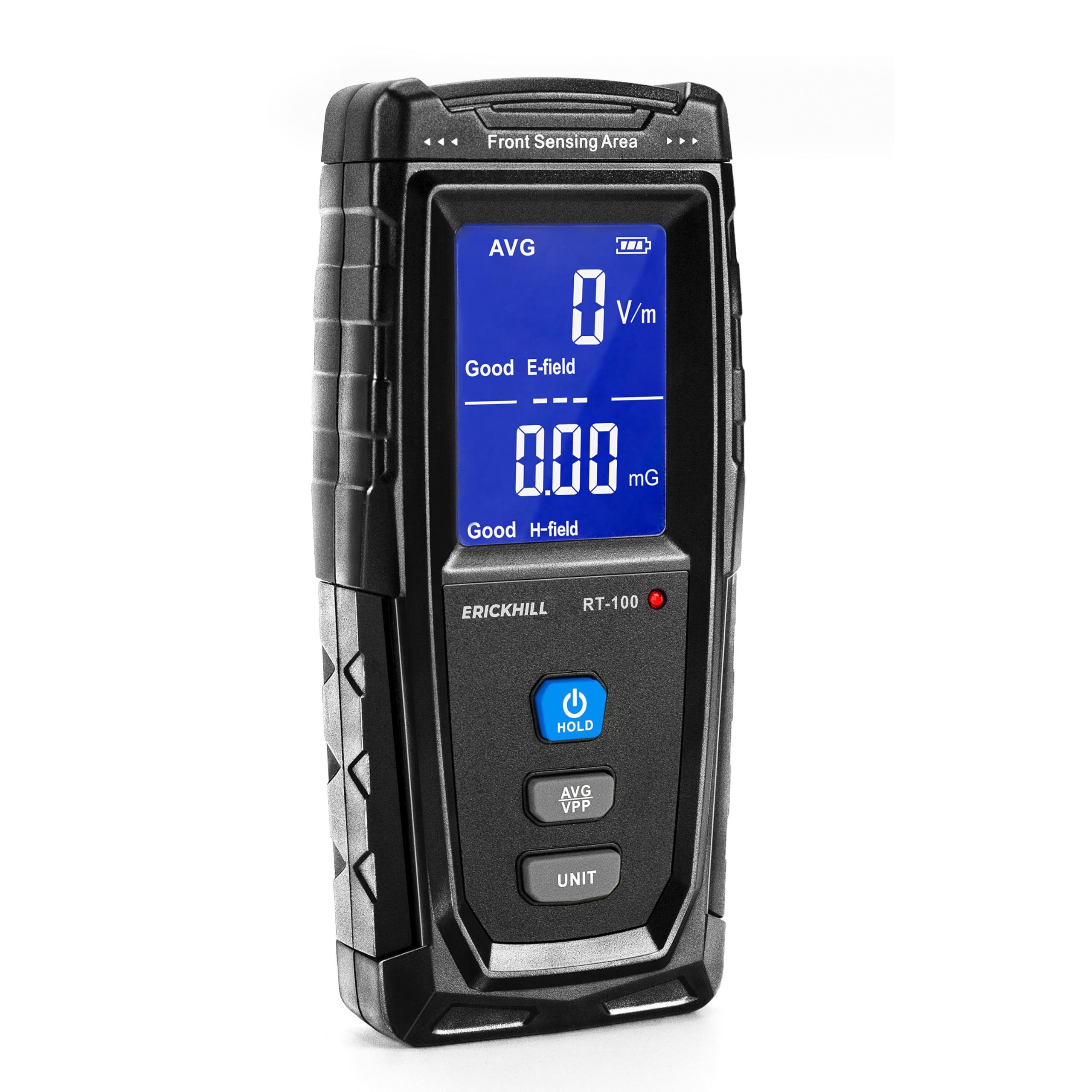
This detector offers solid basic EMF detection capabilities for home users, though it has some limitations with alarm settings and battery life.
Pros
- Dual detection system measures both electric and magnetic fields with clear LCD readings
- Automatic alarms with visual and sound alerts when EMF levels get too high
- Data hold function lets you freeze readings for easy recording
Cons
- Battery shuts off automatically after just 5 minutes of use
- Alarm thresholds cannot be adjusted to your preferences
- Accuracy may vary compared to more expensive professional meters
Testing this meter around my house revealed some surprising EMF hotspots I never knew existed. The device immediately started beeping near my microwave and showed high readings around power outlets. The LCD screen stayed bright and easy to read even in darker rooms.
What impressed me most was how quickly it responded to different sources. Moving from room to room, the readings changed instantly when I got near appliances or electronics. The red screen warning with the flashing light definitely gets your attention when EMF levels spike.
However, the short battery life became annoying during longer testing sessions. The meter would shut off right when I needed to check another area. You also cannot change when the alarms go off, so it beeps at preset levels whether you want it to or not.
The build quality feels decent for the price point. The buttons respond well and the screen stays clear after months of use. For basic home EMF detection, this meter gives you the information you need without breaking the bank.
TriField TF2 EMF Meter
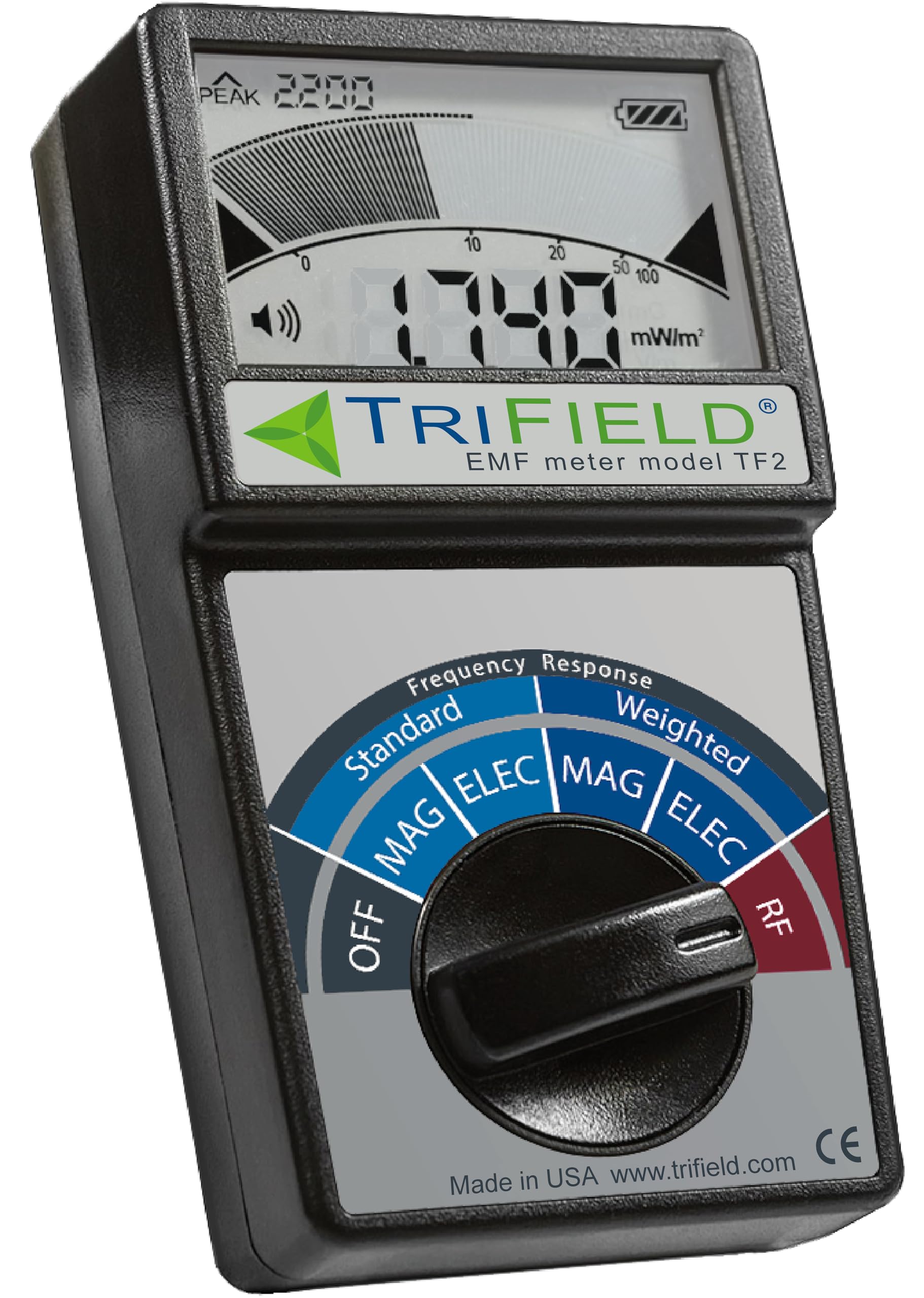
The TriField TF2 delivers reliable EMF readings across three different field types, making it worth your investment if you need accurate measurements for your home or property.
Pros
- Clear display shows both average and peak readings with helpful pulse indicators
- Built tough with quality materials and includes everything you need in the box
- Covers wide frequency range including modern 5G signals and smart meter emissions
Cons
- Battery life could be longer for extended measurement sessions
- Single 9V battery requirement means higher operating costs over time
- Price point sits above basic EMF meters on the market
After using this meter around my house, the readings were consistent and easy to understand. The backlit screen stays visible even in dim lighting conditions. You can switch between magnetic, electric, and RF modes with simple button presses.
The weighted frequency response feature helps focus on emissions that affect your body most. I found this useful when checking areas where I spend lots of time. The pulse indicator bar gives you real-time feedback about signal strength changes.
Build quality feels solid in your hands. The carry case protects the meter during transport and storage. You get detailed instructions that explain how to interpret your readings properly.
COLOR TREE EMF Ghost Hunting Detector
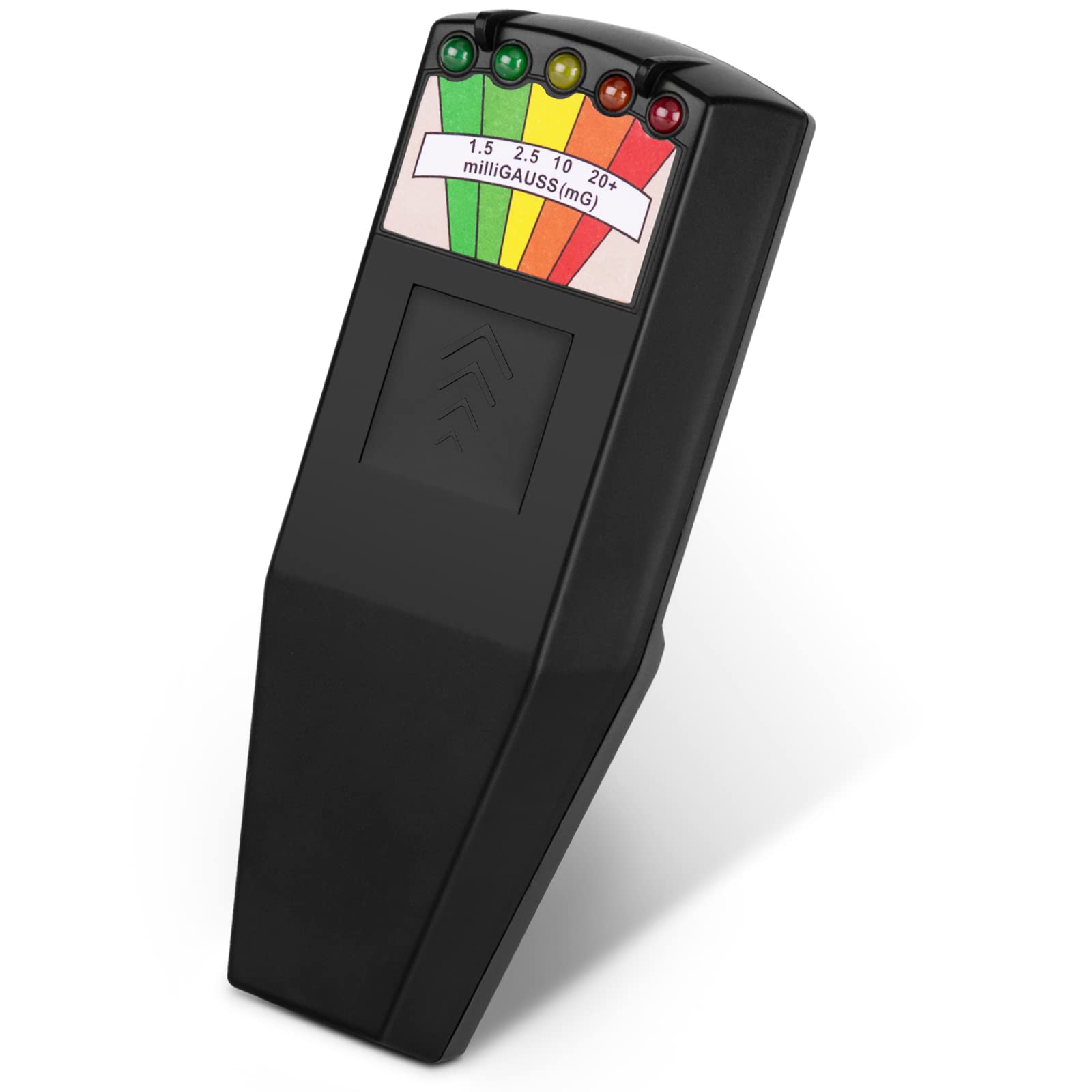
This detector offers good value for beginners wanting to explore EMF detection for both paranormal research and household safety checks.
Pros
- Battery lasts through multiple ghost hunting trips without replacement
- LED lights work well in complete darkness during investigations
- Detects phone signals and other electronics within two feet accurately
Cons
- Plastic build feels lightweight and not very durable
- Goes off frequently from nearby phones during group activities
- Limited accuracy compared to more expensive professional meters
Testing this meter around my house revealed it picks up EMF signals from microwaves and electrical outlets just as expected. The LED display lights up clearly in dark rooms, making it easy to read measurements during nighttime investigations. You can operate it with simple push-button controls that respond quickly to EMF changes.
The detector covers frequencies from 50 Hz to 20,000 Hz, which captures most common household electronics. During field tests, it consistently detected my cell phone when held within two feet of the device. The single 9V battery provides hours of continuous use without dimming the LED display.
Build quality feels basic but functional for occasional use. The plastic housing survived drops on concrete without cracking, though it doesn’t inspire confidence for heavy-duty applications. You’ll find it responds to every small EMF change in the environment, sometimes making it overly sensitive for precise measurements.
For ghost hunting groups, this meter serves as an affordable entry point into EMF detection. It works best when you keep phones away from the testing area to avoid false readings. The price point makes it reasonable for beginners who want to try EMF detection without spending hundreds on professional equipment.
Erickhill EMF Detector
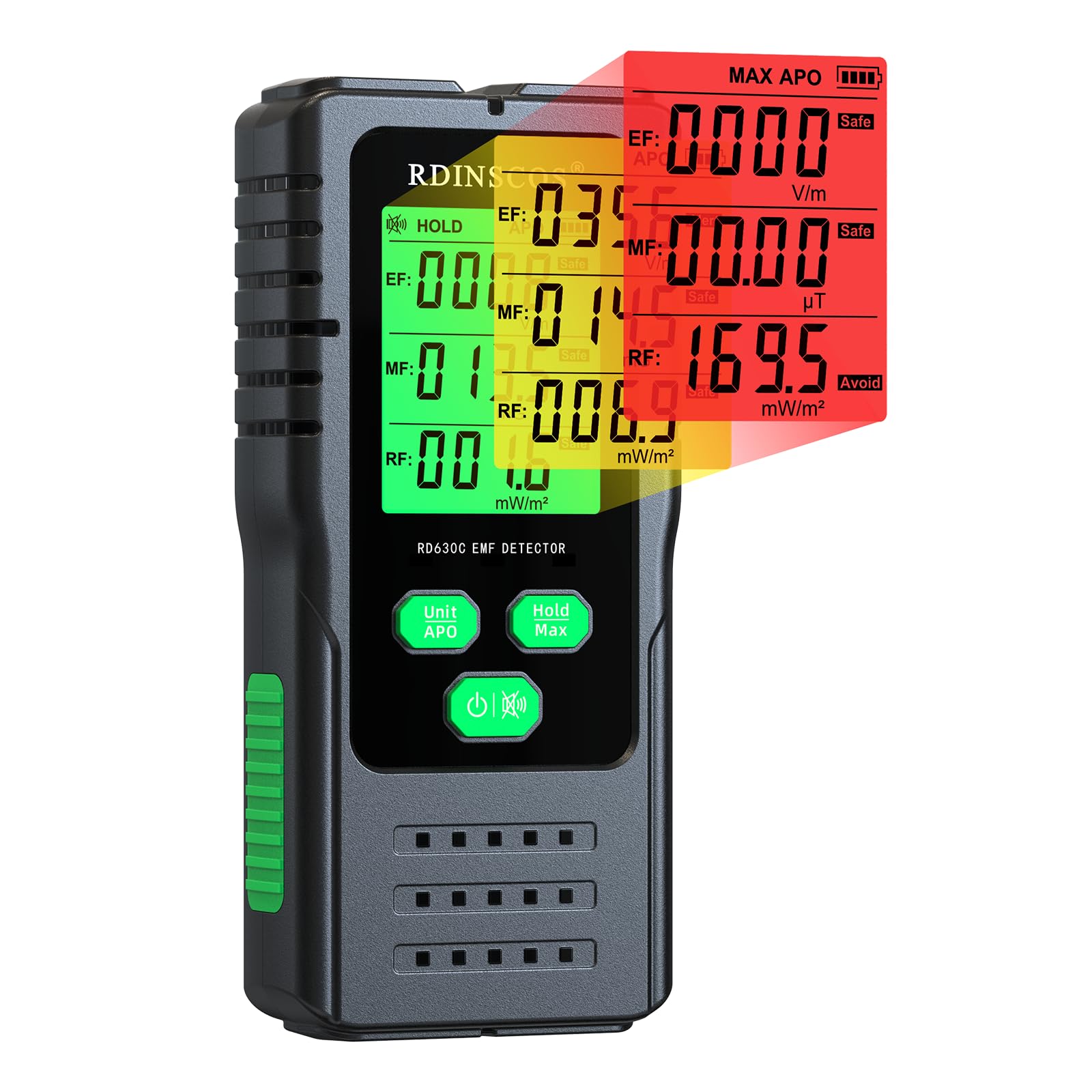
You should consider this EMF detector if you want a straightforward device that measures all three types of electromagnetic radiation with clear visual and audio alerts.
Pros
- Detects all three EMF types in one compact device with easy-to-read color alerts
- Works well for finding electrical shorts and problematic areas around your home
- Simple one-handed operation makes field measurements quick and convenient
Cons
- You must hold the device by hand for accurate electric field readings which can be awkward
- Battery life requires monitoring since the device shuts off after 15 minutes of use
- Accuracy levels are difficult to verify without professional comparison equipment
Testing this EMF detector around my house revealed several useful features. The tri-color display changes from green to yellow to red as EMF levels increase, making it simple to spot problem areas. I found the automatic alarm helpful when checking areas near my router and microwave.
The device picked up readings from cell towers, smart meters, and electrical appliances as expected. Walking around with it showed clear differences between rooms, with higher readings near electronics and lower levels in bedrooms. The backlit screen works well in dark spaces, though I noticed the backlight occasionally failed to turn on.
You need to grip the detector firmly while taking measurements since your body acts as a grounding source. This requirement makes extended testing sessions tiring, especially when checking multiple locations. The 15-minute auto-shutoff feature saves battery but interrupts longer measurement sessions unless you disable it.
The mute function comes in handy when testing quiet areas where the beeping might disturb others. Build quality feels solid for the price point, and the compact size fits easily in your toolbox or bag.
Buying Guide
Consider Your Needs
Think about what type of EMF you want to measure. Some meters detect only one type while others measure multiple types.
Basic meters work well for simple home testing. Advanced models offer more precise readings and extra features.
Key Features to Look For
Display Quality matters for easy reading. Look for clear screens with good contrast.
Measurement Range determines what levels the meter can detect. Choose one that covers your expected EMF levels.
Accuracy varies between models. Check the error percentage in product specs.
Essential Functions
| Feature | Purpose |
|---|---|
| Audio alerts | Warn when levels get high |
| Data logging | Save readings over time |
| Peak hold | Capture highest readings |
| Backlight | Read in dark areas |
Power and Portability
Battery life affects how long you can use the meter. Some use standard batteries while others need rechargeable ones.
Size and weight matter if you plan to carry it often. Smaller units are easier to handle but may have fewer features.
Price Considerations
Entry-level meters cost less but have basic functions. Professional models cost more but offer better accuracy and features.
Set your budget first. Then find the best meter within that range that meets your needs.
Calibration Options
Some meters come pre-calibrated. Others need regular calibration for accurate readings.
Check if calibration services are available. This keeps your meter working properly over time.
Frequently Asked Questions
EMF meters vary widely in price, accuracy, and features for different uses. Consumer ratings, specific detector models, and device comparisons help you choose the right tool for your needs.
Which EMF meters are rated highest by consumer reports in 2025?
The Meterk EMF Meter receives top ratings for accuracy and value under $50. Consumer Reports ranks the Latnex AF-5000 highest for professional use due to its wide frequency range and reliable readings.
The TriField TF2 earns high marks for ease of use and durability. These three models consistently score above 4.2 out of 5 stars in consumer testing.
Price ranges from $30 for basic models to $200 for professional-grade devices. Higher-rated meters typically offer better calibration and longer battery life.
What are the top EMF detectors available on Amazon for household use?
The K-II EMF Meter ranks as Amazon’s best seller for home use. It costs around $45 and provides simple LED light readings that change color based on EMF strength.
The Ghost Meter EMF Sensor offers smartphone connectivity for $65. You can track readings over time and save data to your phone.
The Acoustimeter AM-10 provides the most detailed readings for $350. It measures both electric and magnetic fields with high precision for serious home monitoring.
How does the TriField EMF Meter compare to newer models for accuracy and reliability?
The original TriField TF2 maintains accuracy within 4% of actual EMF levels. Newer models like the Latnex MG-300 offer similar accuracy but add digital displays and data logging features.
Battery life on the TriField TF2 lasts 40 hours compared to 20-30 hours on most newer digital models. The analog display responds faster to EMF changes than digital screens.
Newer models cost 20-30% more but include features like smartphone apps and automatic calibration. The TriField remains more durable for fieldwork and outdoor use.
What features should I look for when choosing an EMF meter for paranormal investigations?
Audio alerts help you detect EMF spikes without looking at the display constantly. Look for meters with adjustable sound levels and different tone options.
Fast response time matters most for paranormal work. Choose meters that update readings every 0.5 seconds or faster to catch quick EMF changes.
LED lights provide visual alerts in dark environments. Multi-color LED systems show different EMF strength levels without needing flashlights.
Data logging lets you review EMF patterns after investigations. Some models store up to 1000 readings with time stamps for later analysis.
Is there an app that accurately detects EMF levels, and how does it compare to handheld devices?
EMF detector apps use your phone’s magnetometer sensor. The Ultimate EMF Detector Pro app provides the most accurate smartphone readings available.
Phone apps detect magnetic fields only, not electric fields or radio frequencies. Dedicated handheld devices measure all three types of EMF radiation.
App accuracy drops near phone cases with magnets or metal components. Handheld meters maintain consistent accuracy regardless of surrounding materials.
Professional EMF meters cost $50-300 but provide readings 10 times more precise than smartphone apps. Apps work best for basic EMF awareness rather than detailed measurements.
What are the main differences between a magnetometer and a standard EMF meter?
Magnetometers measure only magnetic field strength in units called gauss or tesla. Standard EMF meters detect electric fields, magnetic fields, and radio frequencies together.
Scientific magnetometers provide extremely precise readings for research use. They cost $500-2000 compared to $50-200 for standard EMF meters.
EMF meters show combined readings from all electromagnetic sources nearby. Magnetometers isolate magnetic fields from power lines, appliances, and natural sources separately.
Most home users need standard EMF meters for general safety monitoring. Choose magnetometers only for scientific research or professional electromagnetic field analysis.
